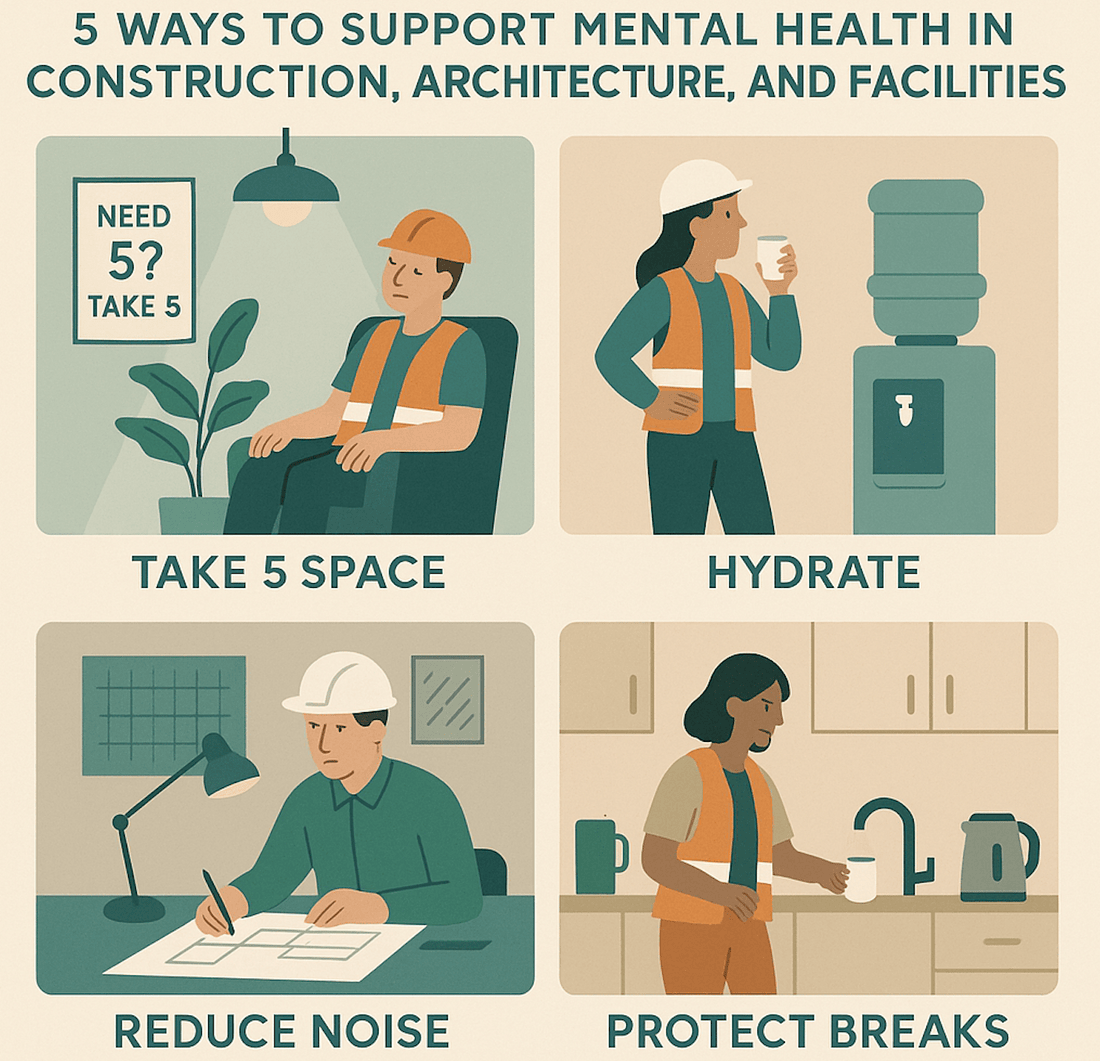It's Mental Health Week, and in the construction, architecture, and facilities sectors, where pressure is high and deadlines are tight, taking care of our mental health often gets pushed down the list. But small changes in the workplace – whether on-site or in the studio – can have a big impact.
Here are 5 quick, practical ways (including tips from experts in their fields) to support your team’s mental health in any built environment.
1. Design a ‘Take Five’ Space
A quiet zone or designated space for short breaks helps reduce stress and supports focus – even in high-pressure environments. It doesn’t have to be big. A corner with soft lighting, a chair, and some greenery works wonders.
"Even during the busiest days, taking a few mindful minutes can reset your mood and mindset. As co-founder of Now Be Present, I’ve seen how simple changes—like a peaceful nook and a gentle reminder to ‘Take Five’—can profoundly impact focus and emotional wellbeing. Our mindful prints are thoughtfully designed to encourage those everyday pauses. They serve as subtle reminders to slow down, breathe, and create a space of calm and clarity in both home and work settings."
– Jacqueline Lindsay, Co-Founder, Now Be Present
Trained Yoga Teacher & Applied Neuroscience Master’s Student
Tip: Add signage like “Need 5? Take 5” and "Pause", to normalise stepping away for a mental reset.
We love Now Be Present's range of Mindful prints

2. Hydrate the Hustle
Did you know? Just a 1% drop in hydration can noticeably impact concentration, memory, and alertness.
Shockingly, a mere one percent drop in hydration could lead to a 12 percent drop in productivity, and a three to four percent drop in hydration could lead to a drop of between 25 and 50 percent, according to Zip Water.
Tip: Make water easy to access. Whether it’s filtered, chilled, or just plain old tap water– encourage regular hydration breaks.
Even installing a filtered water tap in a shared kitchen or breakout area can nudge healthier habits without disrupting the workday.

⸻
3. Turn Down the Volume on Noise Pollution
Background noise – from chatty co-workers to clunky kettles – can be a serious productivity killer. We recently caught Ros Lambert-Porter , Acoustics MD and Principal Associate at Hawkins Acoustics, speaking at The Workplace Event in April. Her talk, “How to Mute Your Coworker,” shed light on the often-overlooked science of sound in the workplace.
“Acoustic design is often considered a dark art,” she explained, “but it has a measurable impact on employee productivity and wellbeing.”
This isn’t a new revelation. Research has been stacking up for over a decade:
-
2011 (Jahncke et al): Office noise impairs performance on complex tasks and hinders concentration.
-
2015 (Seddigh et al): Acoustic absorption boosts perceived sound quality and improves task performance.
-
2020 (Park et al): Poor acoustics strongly correlate with lower job satisfaction and more distraction.
-
2025 (Sun et al): Background noise affects working memory and emotional responses.
Ros highlighted the do’s and don’ts of acoustic planning and shared how thoughtful sound design – from zoning to materials – can transform open-plan chaos into calm, focused spaces.
Inspired by our founder Hannah Freeman, who lives with ADHD, we know how essential it is to offer calm, quiet zones where brains can breathe. Neurodivergent team members especially benefit from environments with low sensory distraction.
Tip: Lichen and moss walls, acoustic panels, and low-noise appliances can make a world of difference.
We love Franke’s Quiet range of sinks – and for a natural solution, check out this article on moss walls as a great addition to office spaces by PHS Greenleaf.

⸻
4. Protect Breaks (and Make Them Inviting)
Fact: Micro-breaks boost productivity by up to 13%.
Make the most of kitchens or communal areas by keeping them clean, comfortable, and well-equipped. A quick tea or filtered water refill should feel like a moment to breathe – not another task.
Tip: Consider adding a boiling water tap to reduce time spent waiting around, especially for large teams sharing a kettle.
⸻
5. Model Mental Health as Part of Culture
The biggest impact often comes from making wellbeing part of the everyday culture. That means open conversations, check-ins, and small gestures that show people matter – like keeping staff areas stocked, clean, and thoughtfully laid out.
Tip: Ask your team what they’d like to improve – it might be as simple as better coffee in the drinks area.
⸻
Final Thought: Good Mental Health Helps Build Great Work
In the built environment, every detail matters – and that includes the details that support your people. Taking small steps to improve mental health at work isn’t just good ethics, it’s good business.
Let’s keep building better spaces – for the projects, and for the people behind them.
...Let’s keep building better spaces — for the projects, and for the people behind them.
We were also lucky to hear from Thomas Wiltshire, founder of Blue Shed HR, who recently shared his expert perspective on why prioritising mental health in the workplace is essential — not just ethically, but economically.
“Mental health affects one in six British workers. It’s the leading cause of sickness absence and is costing UK employers between £33 billion and £44 billion a year 💸. That’s a lot of money—so prioritising employee mental health isn’t just the 'right thing to do', it’s critical for your business’s success.”
Tom points to the Government’s “Thriving at Work” review, which outlines six core mental health standards for employers. A key recommendation is to create a Mental Health at Work Plan, built around:
-
Promoting employee wellbeing
-
Tackling work-related mental health issues
-
Supporting employees with mental health challenges
Want more ideas for supporting wellbeing at work? Stay tuned by joining our Trade Hub, where Tom will also be sharing his insights on inclusive hiring practices with a focus on neurodiversity in the coming weeks!

